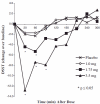Daytime pharmacodynamic and pharmacokinetic evaluation of low-dose sublingual transmucosal zolpidem hemitartrate
- PMID: 17907263
- PMCID: PMC2871168
- DOI: 10.1002/hup.884
Daytime pharmacodynamic and pharmacokinetic evaluation of low-dose sublingual transmucosal zolpidem hemitartrate
Abstract
Objectives: Buffered low-dose sublingual transmucosal zolpidem lozenge hemitartrate (ST zolpidem) is being developed for the treatment of middle-of-the-night insomnia. The objective of this double-blind placebo-controlled cross-over study (n = 24) was to evaluate the pharmacokinetics (PK) and daytime-sedative profile of 1.0, 1.75, and 3.5 mg dose of the formulation.
Methods: Daytime sedation was measured pre-dose and up to 5 h post-dose objectively by the Digit Symbol Substitution Test (DSST) and subjectively using the Visual Analog Scale (VAS). Blood samples for PK assessment was collected pre-dose and up to 12 h post-dose.
Results: The 1.75 and 3.5 mg, but not the 1 mg, ST zolpidem produced significant sedation versus placebo within 20 min of dosing which lasted for up to 3 h. Zolpidem from the formulation was rapidly absorbed and reached maximum plasma concentrations within 38 min of dosing, however the half-life was independent of the dose and side effects were consistent with the known pharmacology of the drug.
Conclusions: ST zolpidem produced rapid, short duration of sedation and the effect was consistent with its PK profile. This novel low-dose formulation of zolpidem may provide clinicians and patients with a prn option for the management of sleep maintenance insomnia.
(c) 2007 John Wiley & Sons, Ltd.
Figures
Similar articles
-
Low-dose sublingual zolpidem tartrate is associated with dose-related improvement in sleep onset and duration in insomnia characterized by middle-of-the-night (MOTN) awakenings.Sleep. 2008 Sep;31(9):1277-84. Sleep. 2008. PMID: 18788653 Free PMC article. Clinical Trial.
-
Post-bedtime dosing with indiplon in adults and the elderly: results from two placebo-controlled, active comparator crossover studies in healthy volunteers.Curr Med Res Opin. 2008 Mar;24(3):837-46. doi: 10.1185/030079908X273327. Epub 2008 Feb 6. Curr Med Res Opin. 2008. PMID: 18257978 Clinical Trial.
-
Gender differences in pharmacokinetics and pharmacodynamics of zolpidem following sublingual administration.J Clin Pharmacol. 2014 Mar;54(3):282-90. doi: 10.1002/jcph.220. Epub 2013 Nov 27. J Clin Pharmacol. 2014. PMID: 24203450 Clinical Trial.
-
Sublingual zolpidem (Edluar™; Sublinox™).CNS Drugs. 2012 Nov;26(11):1003-10. doi: 10.1007/s40263-012-0009-y. CNS Drugs. 2012. PMID: 23034583 Review.
-
Zolpidem's use for insomnia.Asian J Psychiatr. 2017 Feb;25:79-90. doi: 10.1016/j.ajp.2016.10.006. Epub 2016 Oct 12. Asian J Psychiatr. 2017. PMID: 28262178 Review.
Cited by
-
Sensitivity and validity of psychometric tests for assessing driving impairment: effects of sleep deprivation.PLoS One. 2015 Feb 10;10(2):e0117045. doi: 10.1371/journal.pone.0117045. eCollection 2015. PLoS One. 2015. PMID: 25668292 Free PMC article.
-
APD125, a selective serotonin 5-HT(2A) receptor inverse agonist, significantly improves sleep maintenance in primary insomnia.Sleep. 2008 Dec;31(12):1663-71. doi: 10.1093/sleep/31.12.1663. Sleep. 2008. PMID: 19090322 Free PMC article. Clinical Trial.
-
Alcohol calibration of tests measuring skills related to car driving.Psychopharmacology (Berl). 2014 Jun;231(12):2435-47. doi: 10.1007/s00213-013-3408-y. Epub 2014 Jan 10. Psychopharmacology (Berl). 2014. PMID: 24408210 Free PMC article.
-
Middle-of-the-night hypnotic use in a large national health plan.J Clin Sleep Med. 2013 Jul 15;9(7):661-8. doi: 10.5664/jcsm.2832. J Clin Sleep Med. 2013. PMID: 23853559 Free PMC article.
-
Novel sublingual low-dose zolpidem tablet reduces latency to sleep onset following spontaneous middle-of-the-night awakening in insomnia in a randomized, double-blind, placebo-controlled, outpatient study.Sleep. 2013 Feb 1;36(2):189-96. doi: 10.5665/sleep.2370. Sleep. 2013. PMID: 23372266 Free PMC article. Clinical Trial.
References
-
- Greenblatt DJ, Harmatz JS, von Moltke LL, et al. Comparative kinetics, and dynamics of zaleplon, zolpidem, and placebo. Clin Pharmacol Ther. 1998;64:553–561. - PubMed
-
- Hohagen F, Kappler C, Schramm E, et al. Prevalence of insomnia in elderly general practice attenders and the current treatment modalities. Acta Psychiatr Scand. 1994a;902:102–108. - PubMed
-
- Hohagen F, Kappler C, Schramm E, et al. Sleep onset insomnia; sleep maintaining insomnia and insomnia with early morning awakening—temporal stability of subtypes in a longitudinal study on general practice attenders. Sleep. 1994b;17:551–554. - PubMed
-
- Kaplan GB, Greenblatt DJ, Ehrenberg BL, et al. Dose-dependent pharmacokinetics and psychomotor effects of caffeine in humans. J Clin Pharmacol. 1997;37:693–703. - PubMed
-
- Mellinger G, Balter M, Uhlenhuth E. Insomnia and its treatment. Prevalence and correlates. Arch Gen Psychiatr. 1985;42:225–232. - PubMed
Publication types
MeSH terms
Substances
LinkOut - more resources
Full Text Sources
Other Literature Sources





